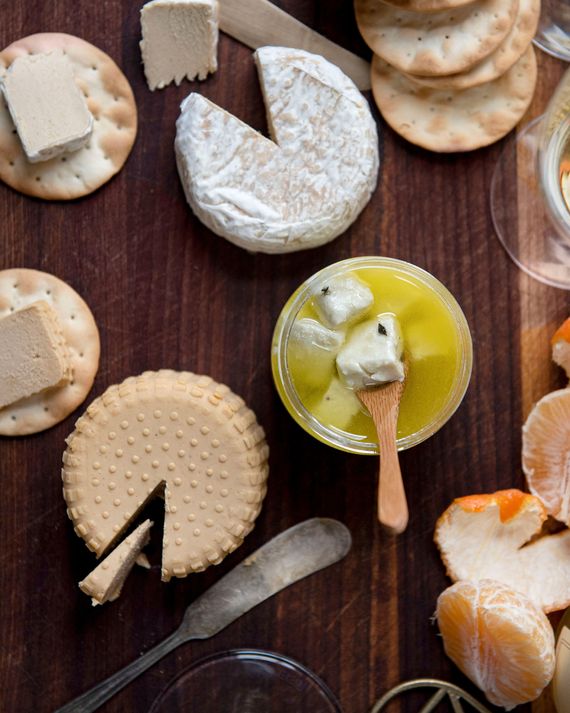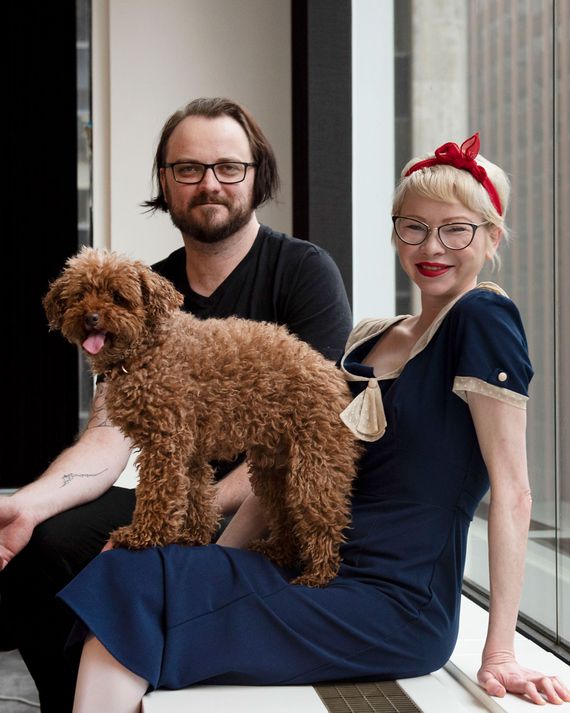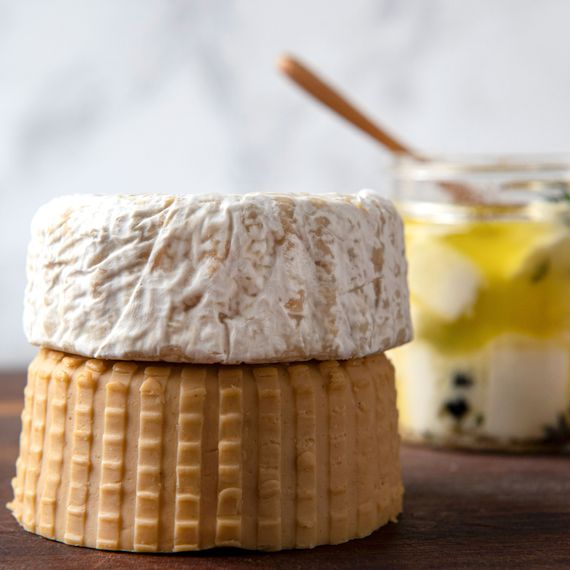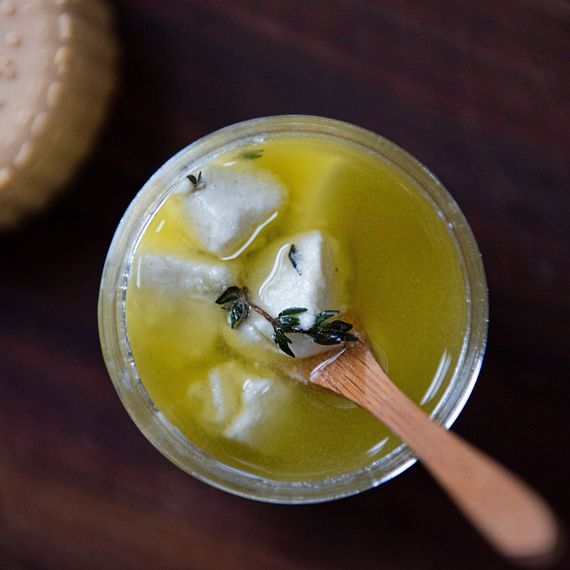
The first thing you notice about the gruyere is that it is overwhelmingly gentle. It is subtly sweet, but it is mellow. It is deeply creamy, but also strangely light, like the cows first moved to Silver Lake and started juicing. Figuratively speaking, it is more vibe than proper cheese. Literally speaking, though, it is also not a proper cheese, because this gruyere is made out of cauliflower. The same is true of the Camembert, which is also made with cauliflower, and the feta, which is modeled after a Danish cow’s-milk interpretation of the Grecian sheep’s milk classic, but is somehow made out of hemp.
Have you ever tried hemp milk? It does not taste like feta, Danish or otherwise. It is a magic trick, some sort of strange alchemy: these products look, feel, and taste like cheese that’s made with some kind of milk; how else do you explain the melty smoothness? The company responsible for this unexpected advance in cheesemaking is called Grounded Foods, and you have almost certainly not yet heard of it, but New York’s chefs are already trying to get their hands on it, and for the people who follow such things, it’s all very exciting.
The not-cheese is the creation of Shaun Quade, who is himself a chef. As recently as 2018, he was a star in Melbourne, Australia, and his “multi-sensory” restaurant, Lûmé, was a molecular-gastronomy wonderland, where, for certain courses, he’d sometimes have his guests donVR glasses. Quade’s kitchen made “Darwinian Egg” orbs out of chicken-leek puree and yolky shells. He fashioned celeriac (a root vegetable) into oysters (a bivalve mollusc). As a guest judge on the show MasterChef Australia, Quade once challenged three finalists to recreate a dish called “Pearl on the Ocean Floor,” a perfect sphere of savory pine-nut-and-miso ice cream encased in a shell of cocoa butter-coated sugar alcohol, which is then nestled on a bed of sea creatures. The recipe involves 150 steps and requires a power drill.
The cauliflower cheese got its start at the restaurant, when Quade’s business partner and wife, Veronica Fil, strongly urged him to add a vegan tasting menu to attract more diners. “He went a bit nuts with it,” Fil says, “because Shaun doesn’t do anything by half.”
Vegan cooking gets an unfair reputation as being either precious or boring, but if you love the trickery of turning foods into other foods, cooking without meat offers a world of never-ending opportunity. “I actually found it a lot more interesting working with vegetables and seeing what you can do with them, coaxing flavors out of what most people would see as like humble ingredients,” says Quade, who is soft-spoken and startlingly unpretentious and seems vaguely embarrassed every time Fil praises him, which is all the time. “It’s just about understanding what each vegetable or fruit is made up from, and then just kind of manipulating it — putting it through different processes without losing the integrity of what it actually is.”
This is how he made an oyster out of celeriac, and this is how he started manipulating vegetables into cheese. It is all part of the same ongoing experiment. “You might be working on something, and then that turns into something else, and then it morphs again,” he says.
The problem with most vegan cheese on the market right now is not that it’s bad. A lot of it is fine, and some of it is actively delicious. It is amazing, what they do these days with cultured cashews! But there is, Quade argues, no plant-based iteration that captures the insidious magic of the real stuff. The word “addictive” gets used a lot to describe food that is merely very good, but the thing about cheese is that it actually might be. “It triggers the same response that you have from smoking a cigarette,” he says. “Same thing with cheese.”
The terrifying beauty of dairy-based cheese is that you just keep wanting more of it, but even when a vegan cheese is excellent, it is usually possible to cut one piece and then stop. When Fil tried Quade’s version, though, she was pretty sure he’d cracked it. “I’m like, hang on, what’s in this? This is crazy. Do you understand what you’ve done?” He did not. She did. This is the elegance of their partnership: there is someone to create the cheese, and someone to seize upon the cheese that’s been created. Fil wants them to be “the Apple of vegan food products,” she tells me, the Steve Jobs to Quade’s Steve Wozniak.
Quade is understandably vague about how he makes the cheese (except to say that it involves fermentation), but the fact that his cheese happened to be allergy-free — unlike most vegan cheeses, it doesn’t have soy or nuts — made it even better. “We can make something from this,” Fil recalls thinking. “This is actually a huge opportunity.”
The original idea was to use the cheese to support a new fine-dining venture they’d been planning in Los Angeles.“Restaurants don’t make money,” Quade says, sounding tired. “Especially now.”
But, Fil adds, “the investors that we spoke to were like, ‘The restaurant concept is interesting, but I’ll give you $2 million straight away to buy the cheese company.’”
For Quade, tabling the restaurant dream to build a fledgling plant-cheese empire was a harder sell. “I think there were a few good months where I might have had some regrets,” he says. But he’d been working in fine dining for 20 years, working 80 or 100 hour weeks, and “over time, it does start to take its toll.”



And then, last August, while Quade was in Los Angeles still negotiating with investors for the dream restaurant, Fil got the call: they’d been accepted into an accelerator program for promising food startups in Melbourne. Before it was even over, they’d been chosen for another: Big Idea Ventures, a program that has a particular interest in “plant-based foods & ingredients, and cell-based meats.” Two weeks after that, they landed in New York, and on the day I met with them, Quade had just been approved to sell the product in the US, which was a relief, because people want their cheese.
“You can kind of tell, a little bit, that it’s not like cheese, but it’s so similar I don’t think it even matters,” says Sam Lawrence, the chef de cuisine at Estela. “And then, what makes it special on top of that is that in and of itself, it’s incredibly delicious.”
If everything goes according to plan, Grounded’s cheese should pop up a small number of restaurants in the coming weeks, that kind of spots that align with Grounded’s ethos, Estela among them. After that, they’ll start selling directly to consumers, by mail. Eventually, the goal is to be everywhere: not only at high-end restaurants and ye olde Brooklyn specialty stores, but also in the cheese case at Gristede’s.
Quade and Fil are, in some ways, unlikely vegan cheese ambassadors, mostly because neither is vegan. In other ways, this makes them exceptionally well qualified: they have not forgotten what actual cheese-based cheese tastes like, and the way Fil tells it, there is no limit to what they might produce. Thirty cheeses, 40 cheeses. They are already developing a separate product line of “less premium” cheeses, including cauliflower-based versions of BabyBel and Velveeta.
Whatever form it takes, Quade and Fil are adamant that they don’t want people to think of it as cheese for vegans. It is partly a matter of artistic pride, but also pragmatism. People don’t like being told how to eat, and besides, vegans already eat vegan cheese. “I’m way more interested in putting it in normal supermarkets, with the dairy cheese right next to it,” Fil says, “and actually challenging ourselves to be good enough that people will pick it because it’s tasty — just choose it because it tastes good.”




